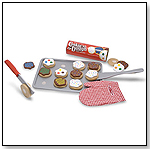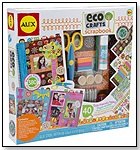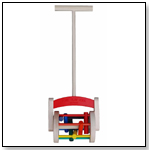|
|
Toymakers and Toy Stores Go Green Growing Movement Sprouts Fresh Initiative
With environmental issues at the forefront of consumer consciousness, toy retailers and manufacturers are turning more attention to protecting our climate and natural resources. The green movement has been largely evident since Toy Fair 2008, and will be supported by an "Earth-Friendly Product Zone" at Toy Fair 2010, but perhaps is not as strong as it could be.  “The toy industry has a little bit of catch-up to play,” Robert von Goeben, president of Green Toys Inc., told TDmonthly Magazine. Citing roadblocks common to developing eco-friendly product, von Goeben explained why he thinks the toy industry isn't on the cutting edge of “green.” “The toy industry has a little bit of catch-up to play,” Robert von Goeben, president of Green Toys Inc., told TDmonthly Magazine. Citing roadblocks common to developing eco-friendly product, von Goeben explained why he thinks the toy industry isn't on the cutting edge of “green.” “It's not particularly easy to really do environmental products in a good way,” he said. “Naturally, you have to look at what goes into your products, but not just the packaging and production. You also need to know your supply chain, and how much transportation is involved.” Even ordering shipping boxes from a local supplier cuts down on carbon emissions, he pointed out. “The industry as a whole has taken a first step, but needs to look at the whole picture,” von Goeben concluded. Here are some ways toy sellers are joining the green movement. 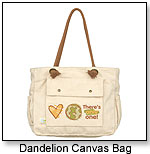 Product Selection. “We went from one or two companies ... to people getting into the market creating specifically green products,” said Kathleen McHugh, president of the American Specialty Toy Retailing Association (ASTRA), about the increase in green toys at the ASTRA Marketplace in June 2009. McHugh told TDmonthly that environmental issues have been a major concern for ASTRA members. “I think it all boils down to what the customer wants. We all see in everyday life that there is a growing movement to take care of the environment.” Product Selection. “We went from one or two companies ... to people getting into the market creating specifically green products,” said Kathleen McHugh, president of the American Specialty Toy Retailing Association (ASTRA), about the increase in green toys at the ASTRA Marketplace in June 2009. McHugh told TDmonthly that environmental issues have been a major concern for ASTRA members. “I think it all boils down to what the customer wants. We all see in everyday life that there is a growing movement to take care of the environment.” Packaging. “I really appreciate when manufacturers send us packaging that is recycled, that doesn't use shrink wrap, and that isn't excessive,” said Lauren Obenour, manager of Green Frog Toys in Portland, Ore. Obenour noted that Green Frog recycles toy packaging for customers who choose to open their purchases in the store so they can play with them immediately. Point of Sale. “Choose products that clearly communicate a benefit to a customer,” von Goeben recommended. “For example, these toys are recycled, or these toys are made locally. Customers want details; the more simple detail and benefit, the better.” Brand new company Greenie2Steps, which manufactures oversized wall art, shares a message not only through the travel adventures of its environmentally friendly elephant, Greenie, but also in the U.S. production of its designs. The peel-and-stick collection is made with inks, adhesive and coatings that are all water based, the company's Cassandra Nicholson told TDmonthly. 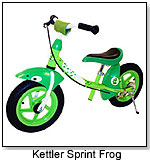 Customer Involvement. “It's about being aware of our own recycling, at home and at work. We've been asking for a while now if customers want a bag at every purchase. It's one way to keep people thinking about it, every visit,” Lesa Smith, owner of Whiz Kids in San Luis Obispo, Calif., told TDmonthly. Smith, who believes it is “very practical” for retailers to consider environmental issues, also hosts art classes using recycled materials, talks to kids about using found items at home, and sells books to help children get involved in green initiatives. Customer Involvement. “It's about being aware of our own recycling, at home and at work. We've been asking for a while now if customers want a bag at every purchase. It's one way to keep people thinking about it, every visit,” Lesa Smith, owner of Whiz Kids in San Luis Obispo, Calif., told TDmonthly. Smith, who believes it is “very practical” for retailers to consider environmental issues, also hosts art classes using recycled materials, talks to kids about using found items at home, and sells books to help children get involved in green initiatives. Community Involvement. “We just became part of this thing called 'Bicycle Benefits' that allows people who ride their bicycles here to get a 10-percent discount,” said Jude Larene, owner of Izilla Toys in Seattle. Third-party Programs. EcoLogo, a third-party certification organization for earth-friendly products and services, announced plans to develop standards for children's products in July 2009. EcoLogo's 12- to 18-month process taps various experts and agencies, inviting participation by any concerned individual. Programs like EcoLogo are designed to build consumer trust by ensuring there is substance behind a company's claim of sustainable and environmentally friendly products, though certification does come at a price for manufacturers. In-store Events. “We had an Earth Day event using the Plan Earth Day kit, and we have a recycled art special event coming up,” said Mary Sisson, owner of Kazoodles in Vancouver, Wash. “Plan Toys has some really fantastic promotional materials for Earth Day,” agreed Obenour. Supply Chain. “A retailer can, by asking a vendor where materials are coming from, put pressure on that vendor to become more conscious of the environmental impact of where their raw materials are coming from, how they are harvested, and how they are produced,” Jamie Kreisman, president of Beka Inc., told TDmonthly. In-store Conservation. “My bag use is down at least 30 percent in the last year,” said Janet Gregory, owner of Over the Rainbow Toy Store in Anchorage, Alaska. “All we do is ask customers if they want a bag, and keep signs on our doors reminding people to bring in their reusable shopping bags from the car. People thank us all the time for the signs.” Quality vs. Price. “If you're buying a product that is going to last longer, you're in all cases contributing in a good way rather than buying something disposable,” added Kreisman, who believes pricing is the primary roadblock to development of greener toys. “Longevity of a product really makes a difference. Yes, this is more expensive, but it will really outlast what you're buying at a big-box store.”  Writer's Bio: Marie Raven has a long history with the specialty toy industry as a family business. In addition to freelancing for TDmonthly Magazine, she writes creative and technical material for various other businesses. Read more articles by this author Writer's Bio: Marie Raven has a long history with the specialty toy industry as a family business. In addition to freelancing for TDmonthly Magazine, she writes creative and technical material for various other businesses. Read more articles by this author |
| |||||||||||||||||||||||||||||||||
Disclaimer Privacy Policy Career Opportunities
Use of this site constitutes acceptance of our Terms of Use.
© Copyright 2025 PlayZak®, a division of ToyDirectory.com®, Inc.

